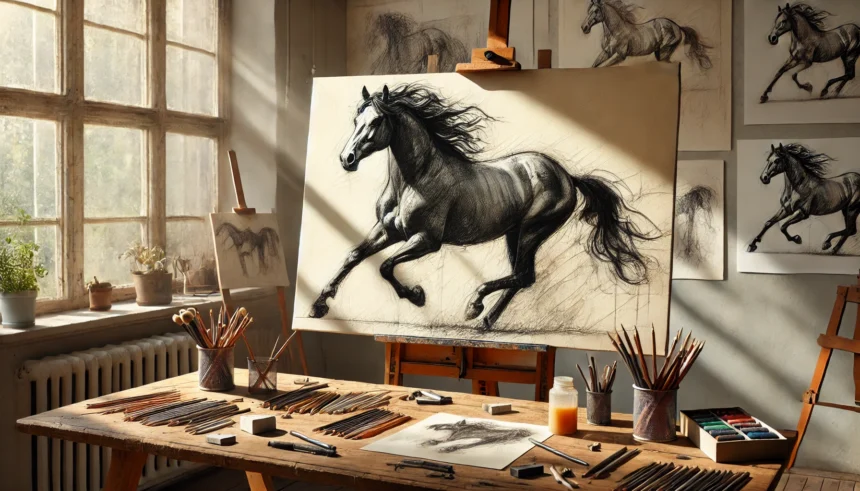Understanding the anatomy of a drawing:v74uyhgg9tq= horse is crucial for any artist who wants to create realistic and proportionate horse drawings. The key to mastering this art form begins with a solid grasp of the horse’s structure, from the alignment of the bones to the muscle layout beneath the skin. Knowing the differences in anatomy across various breeds can also help in adding accuracy to your sketches.
Essential Anatomy Focus Points:
- Musculature: Horses are known for their muscular build, especially in the legs and neck. Pay attention to how muscles bulge and stretch in different movements.
- Skeleton: The horse’s skeleton gives you a guide for proportions. Note particularly the length of the legs compared to the body and the shape of the skull.
- Proportions: Typical mistakes in drawing horses stem from incorrect proportions. A horse’s body can be divided into three equal parts: from the chest to the front leg, the midsection, and from the hind leg to the tail.
Quick Information Table:
| Feature | Details |
|---|---|
| Eye Placement | Slightly to the side of the head, allowing for a wide field of view. |
| Muzzle | Softer, less angular than many other animals, often a focal point in sketches. |
Understanding these aspects of horse anatomy not only helps in creating more accurate drawings but also enables the artist to infuse life and dynamism into their sketches.
Tools and Materials for Drawing Horses
When embarking on the journey of drawing horses, the selection of the right tools and materials plays a pivotal role in the outcome of your artwork. For beginners and professionals alike, starting with the basics like high-quality graphite pencils can make a significant difference. These pencils should range in hardness to allow for a variety of line types—from soft for shading to hard for fine lines. Similarly, using a good eraser and quality sketch pads with thick, durable paper is essential to withstand repeated erasing and sketching without damaging the surface.
In addition to traditional tools, consider the modern artist’s palette, which might include digital tablets and styluses. These digital devices offer versatility with the ability to undo changes and experiment without using up materials. Regardless of the medium, the tools should enable the artist to execute precise details that capture the essence of drawing:v74uyhgg9tq= horse with accuracy and ease. Choosing the right materials is not just about having the best tools but using tools that enhance the artistic process and comfort of the artist.
Quick Information Table:
| Tool Type | Recommended For |
|---|---|
| Graphite Pencils | Basic sketching and detailed line work |
| Digital Tablets | Advanced techniques and easy correction |
Step-by-Step Guide to Drawing a Horse
The process of drawing a horse can be both challenging and rewarding, requiring attention to detail and an understanding of the animal’s form. To start, sketch a simple outline of the horse’s body, using light strokes to establish the basic shape without committing too deeply to any lines that might need adjustment. Next, refine the outline by adding muscle contours and the finer details of the head and legs, emphasizing the flow of the mane and tail to convey movement and grace in your drawing:v74uyhgg9tq= horse.
After the outline is satisfactory, deepen the drawing by shading to bring out the three-dimensional form of the horse. This step involves understanding light sources and how they affect the appearance of muscles and features. The key to a realistic representation is observing how light interacts with the body, creating shadows and highlights that define the horse’s shape. This step-by-step approach not only helps in building up the drawing gradually but also allows for adjustments as the drawing progresses, ensuring that the final artwork of drawing:v74uyhgg9tq= horse captures the dynamic nature and beauty of the horse.
Techniques for Adding Realism to Your Horse Drawings
To enhance the realism in your horse drawings, focus on mastering textural details and the interplay of light and shadow. Texturing is crucial for depicting the smoothness of the coat, the roughness of the mane, and the softness of the muzzle. Techniques such as hatching and cross-hatching can be employed to simulate these textures and add depth to your drawing:v74uyhgg9tq= horse. Furthermore, understanding the muscle structure, as discussed in the anatomy section, allows you to accurately represent the physical traits of different horse breeds.
Another technique to consider is the use of perspective to bring life to your drawings. A horse drawn from a dynamic angle, with attention to the correct anatomical perspective, can evoke movement and realism. By studying different poses and actions of horses, from grazing to galloping, you can effectively capture these various stances in your artwork of drawing:v74uyhgg9tq= horse, making each piece more lively and engaging.
Common Mistakes When Drawing Horses and How to Avoid Them
One of the most common mistakes when drawing horses is getting the proportions wrong. This often results from a lack of understanding of horse anatomy or failing to observe a real horse or good reference images. To avoid this, always start with a rough sketch that outlines the major parts of the horse’s body in simple shapes, checking proportions before detailing. Adjustments are easier to make at this early stage, saving time and effort later in the process.
Another frequent error is overlooking the importance of the horse’s expression and eyes, which are vital for conveying the animal’s mood and personality. Paying close attention to these finer details can make your drawing:v74uyhgg9tq= horse come alive and appear more authentic. Always remember to step back and view your work as a whole to ensure that individual elements are cohesive and realistically portrayed.
Inspiration and Resources
For artists seeking inspiration or additional guidance, numerous resources are available. Art books specifically focused on horse anatomy and drawing techniques can provide valuable insights and examples. Websites and online courses offer interactive opportunities to learn and practice drawing horses in various styles and mediums. Additionally, visiting farms or stables to observe horses in real life can offer firsthand experience and inspiration, which is invaluable for capturing the true essence of drawing:v74uyhgg9tq= horse in your art.
By immersing yourself in both direct observation and studying other artists’ interpretations of horses, you can expand your artistic capabilities and develop a unique style in horse drawing. Remember, the key to success in any artistic endeavor is practice and perseverance, continually refining your technique and approach to each drawing:v74uyhgg9tq= horse.
Read Also: cute:dvql5n9v310= fish
FAQs About drawing:v74uyhgg9tq= horse
1. What is the best way to start drawing a horse for beginners?
To begin drawing a horse, start with basic shapes to form the horse’s body. Sketch a large oval for the body, a circle for the head, and long rectangles for the legs. This helps establish the basic proportions before adding details.
2. How do you get the proportions of a horse right in a drawing?
Understanding horse anatomy is crucial. Divide the horse’s body into three equal sections: the chest, the midsection, and the hindquarters. Measure the length of the head; it should fit three to four times along the length of the neck and body to maintain balance.
3. What are some tips for capturing the texture of a horse’s coat in a drawing?
Use varied pencil strokes to mimic the coat’s texture. Short, soft strokes work well for a smooth coat, while longer, rougher strokes are great for a hairy or winter coat. Pay attention to the direction of the fur growth for added realism.
4. Can you recommend any online resources for learning to draw horses?
Many websites offer free tutorials and video classes. Websites like Drawspace, Proko, and YouTube have specific modules on drawing animals, including detailed lessons on horse anatomy and movement.
5. What is the biggest challenge when drawing horses, and how can you overcome it?
One of the biggest challenges is capturing the dynamic movement of horses. To overcome this, study videos and real-life horses in motion to understand the mechanics of their movement. Practice sketching quick poses to better capture the essence of their motion.





